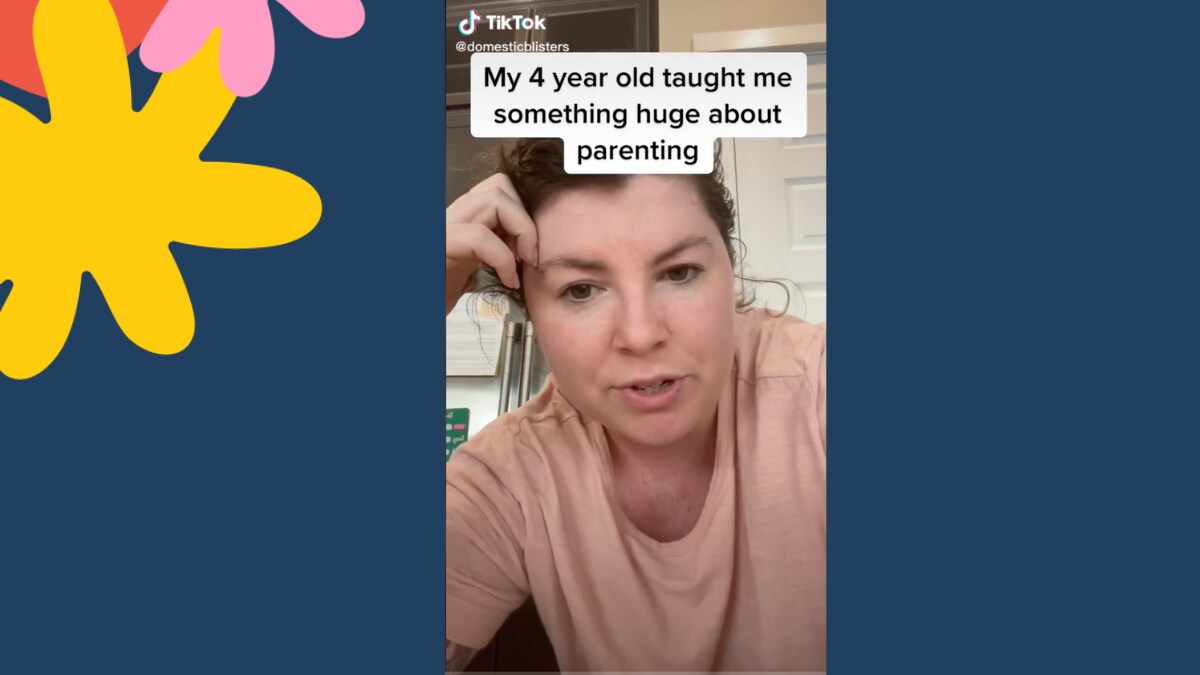Kids are always watching and learning from their parents, and as one popular mom on TikTok found out, that includes parents’ bad habits. KC Davis, a licensed therapist, podcast host and author who goes by the username DomesticBlisters, says her 4-year-old recently gave her a “wake-up call” about the consequences of using threats to enforce her parenting rules.
You could be accidentally teaching your child to use threats to get their way
Davis says her daughter has a wooden stool that she’s allowed to use as practice for her fine motor skills by loosening and tightening the screws. One morning, the preschooler asked for the screwdriver so she could play with this toy, but her mom said no.
“I said, ‘I’m not getting anything out right now until we clean up the downstairs. I don’t want anymore things coming out until we put things back in their places,'” Davis says in her video. “And she goes, ‘If you don’t get me the screwdriver right now, I’m going to unscrew all of the bolts out of the furniture in the house.'”
Davis was taken aback by her young daughter issuing a threat, but then she started to ask herself where her daughter may have learned this communication tactic.
As the video continues, Davis shows a montage of herself using different threats to correct her kids’ behavior:
- “If you don’t put your shoes on right now, we’re not having ice cream tonight.”
- “If you don’t stop unbuckling your seatbelt, we will not watch TV today.”
- “If you come out of your room one more time, we’re not going to go to the zoo tomorrow.”
Davis says the experience made her realize her kids were getting this communication style directly from her.
“I taught her that,” she confesses. “Accidentally, of course.”
The difference between threats and “connected consequences”
Instead of threats, Davis says she recommends parents use connected consequences.
“A connected consequence is saying, ‘Hey, we all have to be safe and kind to each other, and as your parent, if you’re not regulated enough to be safe and kind, I’m going to have to impose some limits on the environment and on you so that you don’t act in a way that hurts yourself or hurts others,” she explains.
For example, she adds, using a connected consequence might mean saying something like, “If you throw toys at your sister, we’re going to have to put those Legos away because that is not a safe way to play with those toys.”
But like any other parent, Davis says it’s easy to lose sight of her best laid plans when parenting gets chaotic. “That [a connected consequence] is my parenting ideal. That’s what I believe in. But when I get frustrated, when I get exhausted, I tend to do the other thing,” she says.
Why there’s no reason to beat yourself up
Davis certainly isn’t the only parent or caregiver who falls back on threats in tough parenting moments. In the comments on her video, dozens of other people shared their experiences with kids mirroring parenting behaviors back to them and how Davis’s video opened their eyes to places they might need to improve their tactics.
One commenter who works as a nanny writes, “I had a kid tell me that if I didn’t let him watch TV, he would tell Santa I was being bad.”
“I used connected consequences with a group of 4th and 5th graders,” adds another TikTok user. “‘If we work on our math and reading for a half hour, we will have extra recess.’ They worked hard, timer went off, we stopped in the middle of a problem and went outside. It built trust and changed our group a lot.”
Davis says she can totally relate to having tough parenting days and feeling like you’re falling short on some of your goals. But, instead of beating yourself up, she tells her followers to think of these moments as an opportunity to create awareness and work on making small changes.
“This was honestly kind of a great check-in moment to bring me back to [asking myself] what I use consequences for and why,” she says. “Then, I could explain to my daughter, ‘Hey, you can’t just threaten to destroy property in the house because you’re not getting what you want.’ It’s hard to say that if that’s how she views what I’m doing.”




